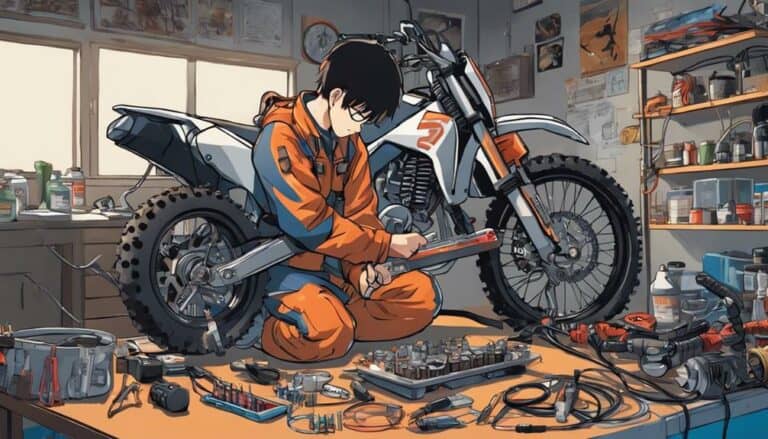Imagine the frustration of revving up your dirt bike only to be met with silence and stillness, no spark in sight.
Before you start dismantling your bike in a panic, take a breath. There's a methodical way to troubleshoot this issue, starting with the spark plug and working your way through the ignition system.
By following a few simple steps, you might just uncover the culprit behind your bike's lack of spark.
Key Takeaways
- Inspect spark plug, wire, and connections for wear or damage.
- Test kill switch functionality with a multimeter for proper operation.
- Check CDI unit for resistance, damage, and burnt components.
- Ensure correct spark plug gap and address any ignition system faults promptly.
Checking the Spark Plug
Inspect the dirt bike's spark plug by carefully removing it and examining the electrode for any signs of damage or wear. Look closely for any cracks, deposits, or erosion on the electrode which may affect its performance. Additionally, check for carbon buildup or oil fouling, as these could indicate underlying engine issues that need attention.
After visually inspecting the spark plug, use a feeler gauge to check the spark plug gap. Make sure that the gap is within the manufacturer's specifications to guarantee proper ignition timing. This step is important for top engine performance and efficiency.
To further assess the spark plug's condition, test it for continuity using a multimeter. If the continuity test fails or if the spark plug shows significant wear, it's recommended to replace it with a new one. A worn-out spark plug can lead to poor engine performance, misfires, and eventually, no spark. By regularly inspecting and replacing spark plugs as needed, you can maintain your dirt bike's ignition system in top condition.
Inspecting the Ignition System
Upon examining the dirt bike's ignition system, make sure to meticulously check the spark plug for any indications of damage or fouling that could impede spark production. Start by removing the spark plug using a socket wrench and inspect the electrode tip. Look for signs of wear, carbon buildup, or oil fouling. A worn-out spark plug may not generate enough spark to ignite the fuel-air mixture, leading to a no spark condition.
Additionally, inspect the spark plug wire for any breaks or damage that could disrupt the electrical connection between the spark plug and the ignition system. A faulty wire can cause a weak or intermittent spark. Ensure the spark plug is gapped correctly according to the manufacturer's specifications. Proper gapping is vital for best spark production.
Testing the Kill Switch
To make certain the proper functioning of your dirt bike's electrical system, utilize an electric meter with a resistance setting to test the functionality of the kill switch.
Start by locating the kill switch on your handlebars. With the electric meter set to resistance, connect one lead to each terminal of the kill switch.
When the kill switch is in the 'off' position, an audible signal should be heard, indicating that the circuit is closed. Conversely, in the 'on' position, there should be no sound, confirming an open circuit.
If there's no change in the meter readings when toggling the kill switch, it may be vital and disrupting the electrical circuit. Disconnect the kill switch from the wiring harness and test the circuit again; this should interrupt the circuit, preventing the bike from starting.
Ensuring the kill switch is working properly is vital for the overall operation of the engine. Make sure to address any issues with the kill switch promptly to avoid starting problems.
Examining the Wiring Connections
Examine the wiring connections meticulously for any indications of damage, corrosion, or loose connections that could be causing the lack of spark issue. Here are three essential steps to guide you through this process:
- Inspect the Wiring Harness: Carefully check the wiring harness for any frayed wires or exposed connections that might be disrupting the electrical flow within the system.
- Test Continuity with a Multimeter: Utilize a multimeter to test the continuity of the wiring connections. This will help identify any breaks in the circuit that could be hindering the spark generation.
- Look for Signs of Overheating: Keep an eye out for melted or burnt wires, as these could indicate a short circuit or overheating problem within the wiring system.
Remember to put everything back securely once you have inspected and repaired any damaged or loose connections. Ensuring that all wiring connections are properly connected is important for maintaining electrical continuity and resolving the no spark issue on your dirt bike.
Troubleshooting the CDI Unit
Inspecting the CDI unit is essential in diagnosing potential issues with spark generation in your dirt bike's ignition system. To troubleshoot the CDI unit, start by testing for proper voltage output and resistance values.
Use a multimeter to measure the resistance across the CDI unit's terminals according to the manufacturer's specifications. Significant deviations from the recommended resistance values may indicate a defective CDI unit.
Additionally, check for any visible signs of damage or corrosion on the CDI unit itself, such as burnt connectors or melted components, which could point towards a malfunction.
If the CDI unit fails the resistance test or shows physical damage, it's likely the source of the spark problem in your dirt bike. In such cases, replacing the CDI unit with a new one that meets the required specifications is necessary to ensure proper spark generation and get your bike running smoothly again.
Conclusion
After thorough investigation and testing, it's clear that the lack of spark on your dirt bike can be attributed to various factors such as a faulty spark plug, ignition system issues, or a malfunctioning kill switch.
By diligently checking each component and following the troubleshooting steps outlined, you can uncover the root cause of the problem and successfully fix your dirt bike's spark issue.
Remember, patience and attention to detail are key in resolving this technical issue.

